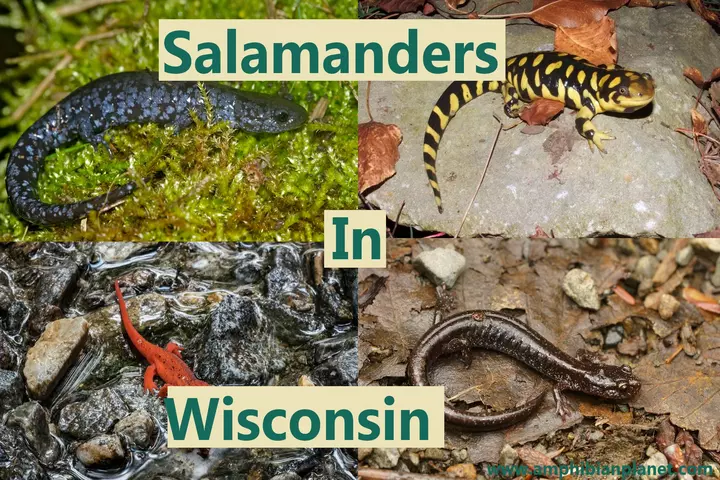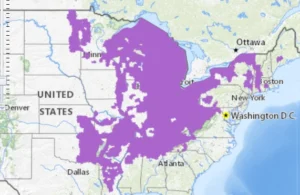The state of Wisconsin is home to 8 species of salamanders. 7 of these species are terrestrial, which means they live on land, but there is also one fully aquatic species.
Of the terrestrial salamander species, the red-backed salamander is considered the most abundant of Wisconsin’s salamanders (in its range). These salamanders can be found throughout much of the northern half of the state.
Other salamanders found in Wisconsin are the blue-spotted salamander, Tremblay’s salamander, eastern tiger salamander, spotted salamander, four-toed salamander, eastern newt, and the common mudpuppy.
These salamanders are silent, and spend most of the year hibernating, or hiding under rocks, logs, and other debris, so people rarely see them.
You are most likely to encounter one of these salamanders on a rainy day in spring when they emerge from hibernation and migrate to breeding ponds.
Native Salamanders of Wisconsin
As earlier mentioned, Wisconsin is home to at least 28 species of salamander, some species more common than others. Since there are so many salamander species, the exact size and coloration vary between species.
If you ever spot a salamander in the state of Wisconsin, It’s probably one of these. You can potentially see salamanders of any age or gender!
1. Red-Backed Salamander

| Scientific Name | Plethodon Cinereus |
| Average Adult Size (Length) | 2– 5 inches |
| Average Lifespan (Years) | 15 – 20 |
Red-backed salamanders have slender bodies and reach between 3 and 4 inches in length. They can easily be identified by their gray or black coloration, and the brick-red dorsal stripe that runs along their back. However, the stripe is not always red. It can be orange, yellow, or even dark gray.
Red-backed salamanders mainly occur in two morphs: The red-back and the lead-back morph.
The red-back morph has a dorsal stripe running down back from the base of the head to the tail, with dark sides. The lead-back morph, on the other hand, lacks the stripe. It has a purely dark gray to black color on its back instead.

There also exists a morph where the whole body of the salamander is a pinkish red, sometimes with black spots.
In Wisconsin, red-backed salamanders are the most abundant salamander within their range. They can be found across much of the northern half of the state.
Red-Backed Salamander Range. Map By: United States Geological Survey.
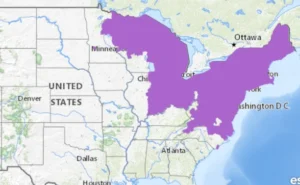
2. Blue-Spotted Salamander

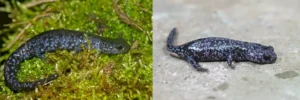
| Scientific Name | Ambystoma Laterale |
| Average Adult Size (Length) | 3– 5 inches |
| Average Lifespan (Years) | 10 – 15 |
Blue-spotted salamanders are relatively slender salamanders ranging from 3 to 5 inches in length. They have a long fleshy tail (accounting for about 40% of the total body length) that is broadly oval at the base and compressed towards the tip.
These salamanders have a gray to blue-black coloration with blue spots on their sides, tails, and legs (hence their name) – and have costal (rib) grooves that are very pronounced along the body between the front and rear legs.
Blue-spotted salamanders inhabit a wide variety of habitats, which include damp woodlands, deciduous hardwood forests, and even the edges of some open fields.
However, due to habitat loss, these salamanders are threatened in many states. Wisconsin is one of the few states where blue-spotted salamanders are still very common. They can be found throughout the state except, the southwest corner.
Blue-spotted Salamander Range. Map By: United States Geological Survey.

3. Tremblay’s Salamander
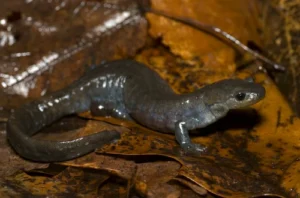
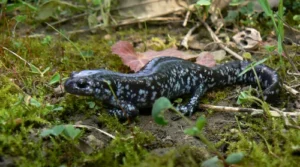
| Scientific Name | Ambystoma Tremblayi |
| Average Adult Size (Length) | 3.7 to 6.3 inches |
| Average Lifespan (Years) | Unknown, but estimated to be 10 – 15 |
Tremblay’s salamanders are a hybrid species of Jefferson salamanders (Ambystoma Jeffersonianum) and blue-spotted salamanders (Ambystoma laterale). They show a blending of characteristics of their parental species.
These salamanders typically measure 3.7 to 6.3 inches in length, and have a black or grayish coloration, with blueish spots and flecks on the sides, legs, belly, and tail, and sometimes on the back.
Since Tremblay’s salamanders look very similar to ordinary blue-spotted salamanders, the main way you can tell them differentiate them from the latter is: Tremblay’s salamanders tend to be longer and paler than the blue-spotted salamanders.
Tremblay’s salamanders are unique in that they are all female complex – which means all Tremblay’s salamanders are female. Due to this, these salamanders reproduce asexually using a breeding strategy called ‘kleptogenesis‘.
To reproduce, the females steal sperm from male blue-spotted salamanders. However, the sperm isn’t to fertilize the eggs, rather, it induces the eggs to develop independently.
The result is that the offspring are exact clones of their mothers without the contribution of genetic material from the sperm. Also, the offspring are all female.
In Wisconsin, Tremblay’s salamanders can be found in the northern part of the state, sharing their range with blue-spotted salamanders.
4. Eastern Tiger Salamander
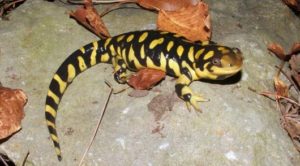
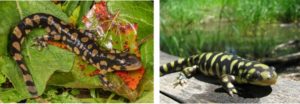
| Scientific Name | Ambystoma Tigrinum Tigrinum |
| Average Adult Size (Length) | 6 – 9 inches |
| Average Lifespan (Years) | 15 – 25 |
Eastern tiger salamanders typically range from 6 to 9 inches but can grow up to 13 inches, which makes them the largest terrestrial salamanders in Wisconsin.
These salamanders are generally black with olive-yellow to brownish-yellow spots or irregular blotches (“tiger stripes”), on the head, body, and tail. The underside is yellow.
Young tiger salamanders sometimes have an extremely dark coloration with very little noticeable patterning, and sometimes have black spots.
Eastern tiger salamanders can be found in grasslands, savannas, and woods throughout much of Wisconsin, except in the northern part of the state.
Eastern Tiger Salamander Range. Map By: United States Geological Survey.
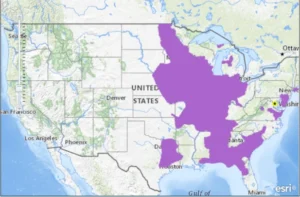
5. Spotted Salamander


| Scientific Name | Ambystoma Maculatum |
| Average Adult Size (Length) | 6 – 9 inches |
| Average Lifespan (Years) | 15 – 20 |
Spotted salamanders (sometimes called “yellow-spotted salamanders“) are fairly large, ranging from 6 to 7 inches long, with females typically larger than males.
They get their name from the two roles of yellow or orange spots speckled along their black backs and sides. These spots often appear in two relatively distinct rows before merging into one on the tail.
Often there are two orange spots at the base of the head. The underside is pale gray with no spots.
Spotted salamanders have broad heads and thick, heavy bodies with obvious vertical grooves on each side of their body.
In Wisconsin, spotted salamanders are found much of the northern half of the state, as well as the eastern part of the southern half.
Spotted Salamander Range. Map By: United States Geological Survey.

6. Four-Toed Salamander


| Scientific Name | Hemidactylium Scutatum |
| Average Adult Size (Length) | 2– 4 inches |
| Average Lifespan (Years) | Unknown, but estimated to be 8 – 12 |
Four-toed salamanders range from 2 to 4 inches in length. They get their name from the four toes on both their front and hind feet. (Most salamanders have five toes on the back feet, and four on the front feet).
Four-toed salamanders have a reddish-brown or gray-brown coloration on the back, with gray sides and a white belly with black spots.
These salamanders also have an obvious constriction at the base of the tail where it can detach if grabbed by a predator, allowing the salamander to escape.
In Wisconsin, four-toed salamanders are currently listed as a species of special concern. They are found throughout much of the state where older forest cover is intact, however, their range in Wisconsin has not been properly recorded because they are hard to find.
Four-toed Salamander Range. Map By: United States Geological Survey.

Newts in Wisconsin
Salamanders are often informally divided into two groups: “Newts” and “true salamanders”.
Salamanders typically have smooth moist skin while newts tend to have more rough, grainy skin. In simple terms, newts are a specific type of salamander.
There is only one type of newt in Wisconsin
7. Eastern Newt


| Scientific Name | Notophthalmus Viridescens |
| Average Adult Size (Length) | 2 – 4 inches |
| Average Lifespan (Years) | 12 -15 |
Eastern newts grow between 2 and 5 inches in length and are the only newt species found in Wisconsin. Unlike most salamanders, many newts (including the eastern newt) have rough skin that is slightly moist, (just enough to keep it from drying out.
In the Juvenile eft stage (which lasts about 3 to 4 years), eastern newts have a bright orange-red coloration with a rounded tail.
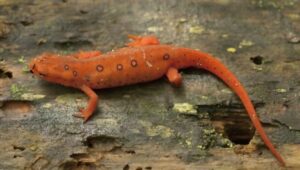
As adults, they generally have a yellowish-brown to greenish-brown coloration, with black-bordered red spots along their backs. Their tail is also less rounded and is paddle-shaped to help them swim as these newts are highly aquatic in their adult stage.
Males develop enlarged hind legs and a high wavey crest on their tails during the breeding season.
Eastern newts are found in the eastern part of Wisconsin – and are often found not very far from a water source.
Eastern Newt Range. Map By: United States Geological Survey.
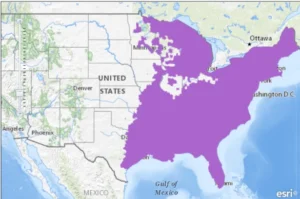
Aquatic Salamanders in Wisconsin
Unlike terrestrial salamanders, aquatic salamanders live entirely in the water, even after transforming into adults. This means they have features that are adapted for life in the water, rather than on land.
Aquatic salamanders have more varied features than terrestrial salamanders. Some aquatic salamanders have 4 legs, but others only have forelegs and lack hind legs. Some have gills, but others do not and largely breathe underwater through their skin.
However, despite their varied features, all aquatic salamanders have flat paddle-like tails which they use to swim in their aquatic environments.
There is only one aquatic type of salamander in Wisconsin.
8. Mudpuppy


| Scientific Name | Necturus Maculosus |
| Average Adult Size (Length) | 7 – 16 inches |
| Average Lifespan (Years) | 15 – 30 |
Mudpuppies reach 7 to 16 inches and are one of the few salamanders that are vocal. They get their name from their squeaky scream which sounds somewhat like a dog’s bark.
Their large size makes them the largest species of salamander – and the largest species of amphibian in the state of Michigan.
Mudpuppies are fully aquatic for their whole lives and retain their larval features even as adults. They have large feathery gills, four feet, and a flat fin that runs down the length of their body.
Their coloration is usually brownish-black with bluish-black spots or blotches. However, younger mudpuppies are often black with yellow stripes running along the length of their bodies.
Since mudpuppies keep their gills and other larval features as adults, they are often mistaken for tiger salamander larvae. The most effective way to tell them apart is: mudpuppies only have four toes on their hind feet, while tiger salamander larvae have 5 toes.
Mudpuppies can be found in clear creeks, rivers, deep inland lakes, and other cool, oxygen-rich waters throughout much of Wisconsin.
Mudpuppy Range. Map By: United States Geological Survey.
Frequently Asked Questions (FAQS)
Black salamanders in Wisconsin? Black salamanders in Wisconsin could be spotted salamanders, tiger salamanders, or lead-back morph red-backed salamanders.
Blue salamanders in Wisconsin? The only blue salamanders in Wisconsin are blue-spotted salamanders and Tremblay’s salamanders.
Are salamanders endangered in Wisconsin? No salamanders are not endangered in Wisconsin. There are no salamander species that are listed as endangered in the state – however, four-toed salamanders are listed as a species of special concern.
Are Wisconsin salamanders poisonous? All terrestrial salamanders are poisonous to a certain degree. When threatened, they secrete skin secretions that taste bad to predators. However, most salamanders in Wisconsin are only mildly poisonous and are of no serious threat to humans or pets. The only highly poisonous salamander in Wisconsin is the red-eft stage of the eastern newt.
Where to find salamanders in Wisconsin? Most terrestrial salamander species in Wisconsin are terrestrial. They can be found in shady, forested areas, not far from a water source – and often hide in moist locations such as under rocks, logs, and other debris. You are most likely to encounter one of these salamanders in the spring because that is when they are most active.
Conclusion
Wisconsin has at least 8 salamander species, with some species being more common than others.
There are salamanders small enough to fit in the palm of your hand, but they’re also large salamanders such as the tiger salamander
These fascinating amphibians are all over Wisconsin, and you’re sure to catch sight of one eventually if you take the time to look, especially in the springtime when they are most active.

